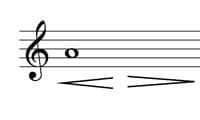While singing fast and loud can be natural and easy for some of us, singing slow songs is totally different.
When the singing slows down and you’re supposed to either hold tough notes longer or add that extra emotion,
what tends to happen is that the bottom of the performance drops off and It ends up sounding like an actor who is trying to act.
What can be done to sing slow songs with power and emotion without overdoing it?
Mastering slow songs
So how do we sing slow songs? Singing slow songs requires mastering certain vocal technical aspects. Breathing technique is key! This includes flexible support in the body. In slow songs, you must sing longer without taking a breath. The notes should usually be even (depending on the style) even though you sing several notes in a row.
A slow song/ballad is a melody that has a slow tempo and possibly long notes written into that melody. That means you have to hold the notes without wavering and connect them to other notes as well, often without taking a breath in between.
Why would you not be allowed to breathe?
If the text has words that belong together it feels funny to take a breath between them. Even in a slow tempo, the text should have a meaning with phrases that could be spoken intelligently, while telling a story.
Let’s take classical singing as an example: In classical singing, connecting the notes has a special value and meaning. It could be said that a piece should be played “legato” (Italian for connecting) – likewise, singing legato is a very important vocal skill.
If we observe another genre, like pop or rock, this is not as much required. We hear breaths taken even in the middle of words, and this can be done for the sake of artistic effect.
Want to learn how to sing? Follow the link:
https://48f4djqfnm9sfo2enbqn33–dy.hop.clickbank.net/?tid=7278
Why do we run out of breath?
Let´s take the famous Ave Maria by Schubert. It is a classical song but sometimes performed as a cross-over hit. If you sing “Aaa-ve – breath – Mari-i-ia, would you do that on purpose? Or would you do so because you ran out of breath after the Ave?
If a classical singer sings this song breathing there, it is considered plain disastrous technically, but in another genre, this could be interpreted as an artistic choice. So, singing slow songs is to a very great degree dependent on good breathing technique but also dependent on the genre or style.
- Mastering airflow: This is at the core of vocal skill: mastering the airflow. We must give just enough air to enable the vocal folds to vibrate but at the same time hold back the air pressure and regulate the airflow. This happens with the body and only slightly with the larynx itself. So you should develop your breathing musculature – both the inhaling and the exhaling muscles with proper exercises.
Here is a good basic breathing exercise:
Preparation
Check your posture and stall tall. Lift your arms high above your head and stretch your neck and spine. Inhale. Then exhale through your mouth slowly and let your arms return to the sides of your body. Feel how much more open the ribcage now feels with your shoulders relaxed and further back than before.
Now the Excercise
Sniff 3 times through your nose and expand your waist every time. You are now in the inhaling position.
Engage your abdominal muscles lightly (do not become hard or stiff).
Start to exhale as slowly as possible making a hissing sound ssss. Extend this outbreath counting to 10. Try to keep the ribcage open as wide as at the beginning for the initial part of the hiss; then gradually let the ribs come down too without collapsing; keeping your good posture. Repeat.
Practicing this breathing exercise will gradually give you more control over the breathing muscles and make you aware of the body for singing. The count may even increase to higher numbers than 10.
For another more advanced exercise skip to the bottom of this post!
Why do we run out of breath? Continued
- The vocal folds should close neatly, so very little air passes through them while making a sound. If the folds close incompletely there will be wild air that causes a breathy tone.
The reasons behind inadequate vocal fold closure (adduction) are many (your folds may be tired or swollen, you are sick and therefore hoarse etc.). But assuming you and your vocal folds are healthy you can learn to sing fast and slow. Inhaling properly and exhaling skillfully is key in the technique to sing slowly.
- Tension: Even if the singer has great breathing skills, the sound may still be unsatisfactory when notes are very long. In slow songs, there is more time for observing the evenness, pitch, and vibrato of the singer.
Singing without vibrato can be an artistic choice or can depend on the stiffness of the vocal folds themselves or the tension in the larynx. The singer may “hold” the sound in which case the sound is also not free. This holding usually involves tension in the throat and neck muscles as well as the root of the tongue or the jaw. This can also cause excessive vibrato (the wobble) or uneven bursts of vibrato on any note if there is too much tension.
Singing off-key is one of the negative side effects. In a slow song, the listener will have time to observe all this.
- Registration: The question of registration is important. This means how thick or thin your vocal folds are at any given pitch. Generally, the folds are thick on low notes and thin on high notes.
If you sing with an uneven tone and would like to have it more balanced you might want to consider your mix. This means varying the thickness of the vocal folds. See the exercise below for practicing this!
Ideally, if the mixing of registers is flexible and the laryngeal mechanism is balanced, it feels easy to hold a note as long as you like and you are not losing much air – then you can sing long phrases as you wish.
- Too little CO2: When we are nervous in performance it may seem that we run out of breath faster than in the practice room. The reason for this can be over-breathing. The effects of stress diminish the carbon dioxide in our body. Therefore we feel the need to take a breath. This is natural but could be reduced if we also learn to manage our nerves.
But for a beginning singer, this phenomenon is frustrating. That is why it is wise to plan the breathing in such a way that there are no extra long phrases unless you are very experienced and know how your body reacts under pressure.
Even though it can be stated that in general, people find slow songs more difficult than fast ones, it is down to the voice type you have. If your voice is very heavy it´s like a big vessel that cannot change course fast; likewise, it might not want to change between notes very quickly. In that case, you might find slower songs more comfortable. However, here we must generalize a little.
Exercise: Messa di voce – regulating the vocal folds´ thickness

Begin a note in your comfortable range very softly, quietly (pianissimo). Make sure the start of the sound is balanced (not too breathy and not too hard) and continue to sing on that pitch making it gradually louder (crescendo). Sing in your own best loud/forte sound. Then start to diminish the loudness also very evenly (diminuendo) until you come back to the original soft pianissimo.
You will notice how your body must work hard to keep the sound long and even. It will teach you the balance of your breathing muscles (the support) and how to increase and decrease pressure with them. At first, only attempt shorter sounds until you feel in control. Then make these sounds longer and longer. Make sure the pitch or the vibrato do not waver. This exercise is super important and will give you great control if you practice it wisely!
Related Questions
How can I support those long notes better?
This question is at the heart of vocal technique. Regulating the air flow and finding just the right pressure for all pitches requires a careful balance of the muscles of the torso. Keep in mind that we have muscles for inhalation (of which most important is the diaphragm) as well as muscles for exhalation (mostly the abdominal muscles). The idea is to activate them both at the same time! That is how we don´t push the air out too quickly and gain control over the flow. This gives us a feeling of contact between the body and the sound – as if we were singing with the whole body.
How can I find the mix for better balance in my singing voice?
Imagine your vocal folds like elastic bands. When they stretch you get a higher pitch. If you sing with a heavy sound it will not be as easy to stretch them and go higher. So, to find the mix you need to lighten the contact of your vocal folds and let them get thinner. The sound becomes lighter but it should not become breathy. Initially, there may be a break where controlling this change is challenging but with practice, you can even out this range. (Unless you actually want the break to be audible, like in yodeling).
Have you always wanted to become a great singer?
https://48f4djqfnm9sfo2enbqn33–dy.hop.clickbank.net/?tid=7278

